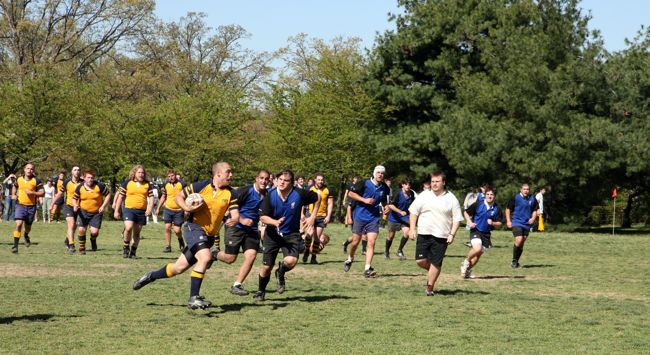
How to Introduce Power Phases for Athletes
For athletes, it’s important to build strength levels using the big exercises—the squat, deadlift, bench, pull-ups, and other similar movements. By doing so, they will get faster and more explosive up to a certain point.
There is a point of diminishing returns where getting stronger won’t transmute into increased speed and power. When this happens, you have to shift the training to include more power exercises and maintain the athletes' high strength levels. However, this level of strength is likely to be somewhere around a double body weight squat or more, so your athletes need to be pretty damn strong before you have them go on to exclusive power phases!
Build Extra Power and Speed
I'll assume your athletes haven’t reached a double body weight squat yet but still want to add in some extra power and speed work. The emphasis still needs to be on strength development, but now we can add in a couple power exercises.
A lower body power and strength workout will look something like this:
- 1A: Box squat, 4 x 5 reps
- 1B: Box jump, 4 x 5 reps
- 2A: Sled drag, 4 x 10 meters (really heavy)
- 2B: Sprint, 4 x 10 meters x 2 (changing the front foot each time)
- 3A: Glute ham raise, 3 x 8
- 3B: Abdominal wheel, 3 x 8
You don’t have to follow this model exactly, but let me explain it. We’re starting out with a strength exercise coupled with a power exercise, squats, and jumps. This will build strength and also help increase jump power or increased rate of force development (RFD). The movements are similar and so the neural stimulation during the workout will mean that the squats will help you jump higher and vice versa.
Then we move on to sprint training. Again, using a heavy 10-meter sled drag with a fast 10-meter sprint, these two exercises will carry over to each other during the workout. Basically, the sprints will ‘feel’ easier after a heavy sled drag and you should (theoretically but usually) run faster!
Finally, the workout ends with basic hypertrophy work for the abs, lower back, and posterior chain. This basic strength and power workout starts off with strength, moves on to speed, and then ends with hypertrophy. It's a pretty simple but effective training plan that anyone can use. Just plug in your own exercises!
The main point here is that we are building or maintaining strength levels while introducing new exercises. This is a huge point for the continual development of your athletes.
Now you have a workout template to use to build up strength and power levels. When you need to emphasize a specific quality such as sprint speed, stick it in the middle portion of the workout (as above) for three to four weeks. Once a good level of technique and skill has been learned, move the same exercise to the number one slot in the workout and just change the exercise that it’s coupled with.
Second Training Block
So. for four weeks. you might use a sled drag back-to-back with sprints as your 2A and 2B exercises—the ‘middle’ portion of the workout. Then for the second four-week block, you can switch to using sprints first as a 1A exercise back to back with another similar exercise but for strength (e.g. heavy Prowler sprints).
This gives the athlete four weeks to learn how to do the exercise and then four weeks to train it hard first thing in the workout. You will receive much better returns than if you simply said, "Right, let’s start a power phase" because now you’re saying, "Right, let’s take four weeks to get ready for a power phase while still building strength levels."
A workout for the second four-week phase could look like this:
- 1A: Prowler® sprint, 5 x 10 meters (heavy)
- 1B: Sprint, 5 x 10 meters x 2 (changing the front foot each time)
- 2A: Box squat, 3 x 5
- 2B: Box jump, 3 x 5
- 3A: Glute ham raise, 4 x 6
- 3B: Hanging knee raise, 4 x 6
As you can see, the emphasis is now on sprint speed. Lower body strength is still being maintained, and the posterior chain and abdominals are being trained harder (either by adding more weight or by using a tougher progression for lower reps) to compliment further strength gains.
If it works for the athlete, you can use the same workout once a week or twice a week with one high intensity day and one moderate or low intensity day (depending on where you are in the training year or whether you have any other competitive commitments). This part is up to you.
Just remember that when starting a power phase, the more accustomed the athlete is to certain exercises and loading parameters during the previous phases, the better they will progress on a new phase.









